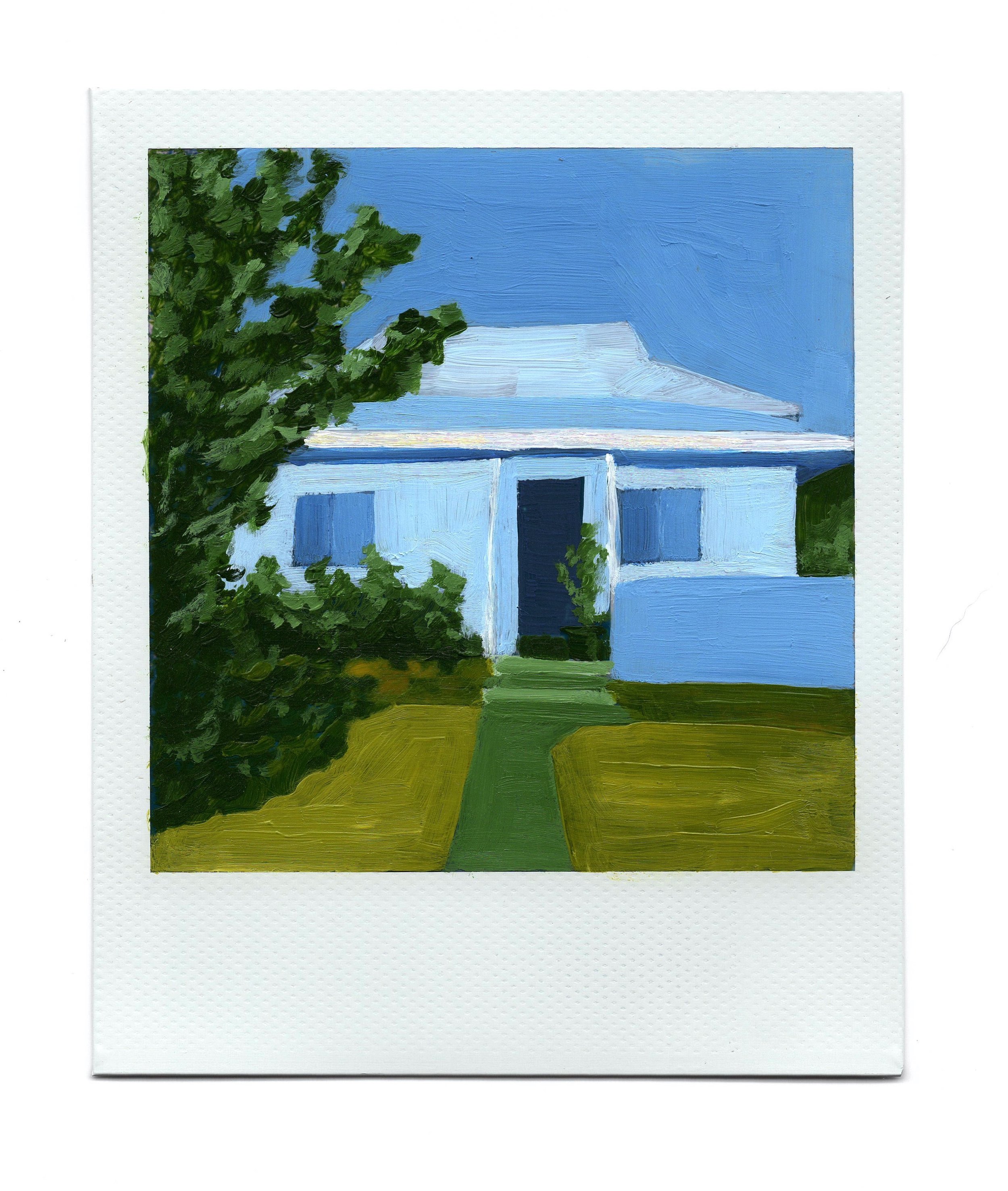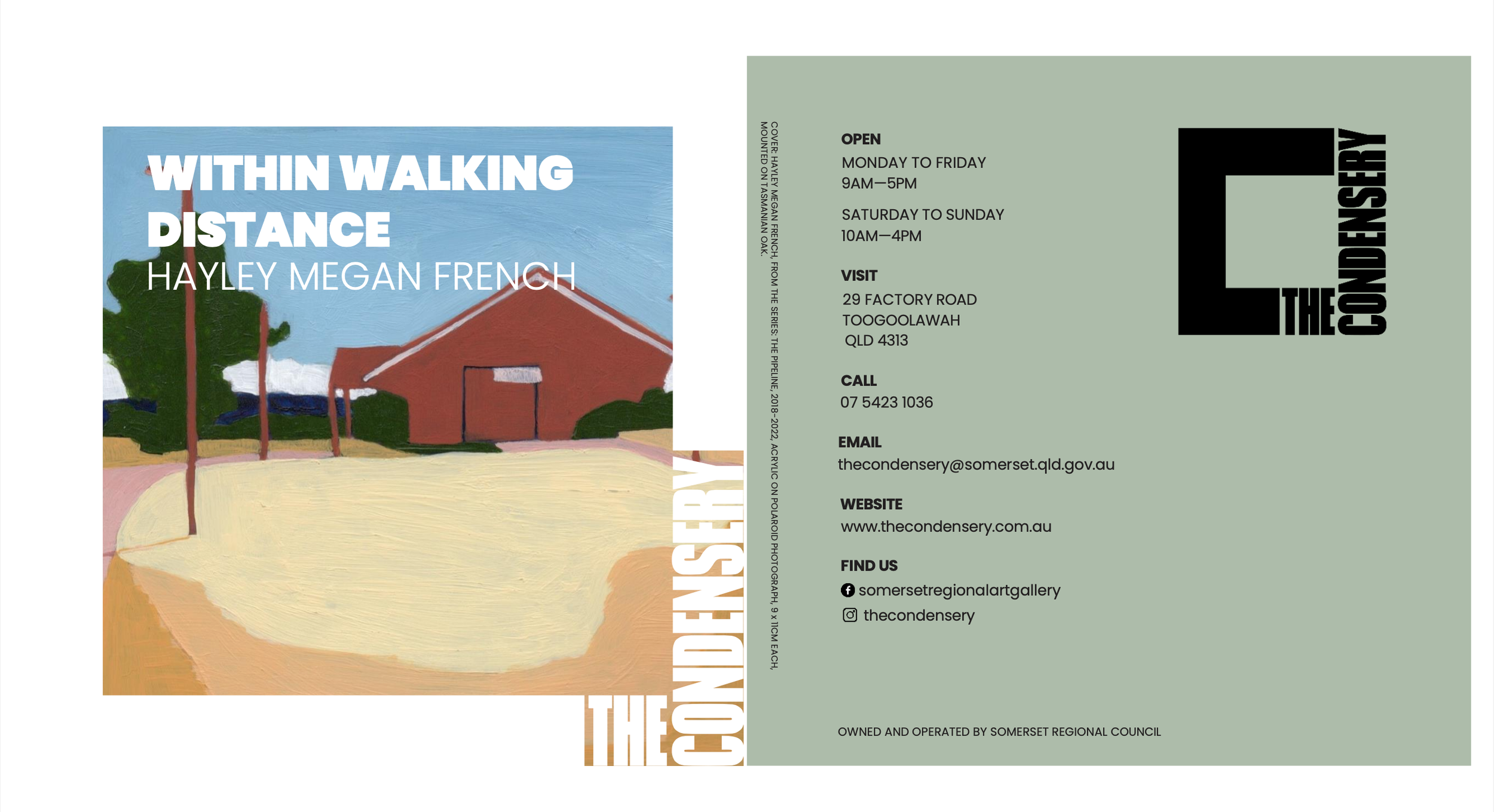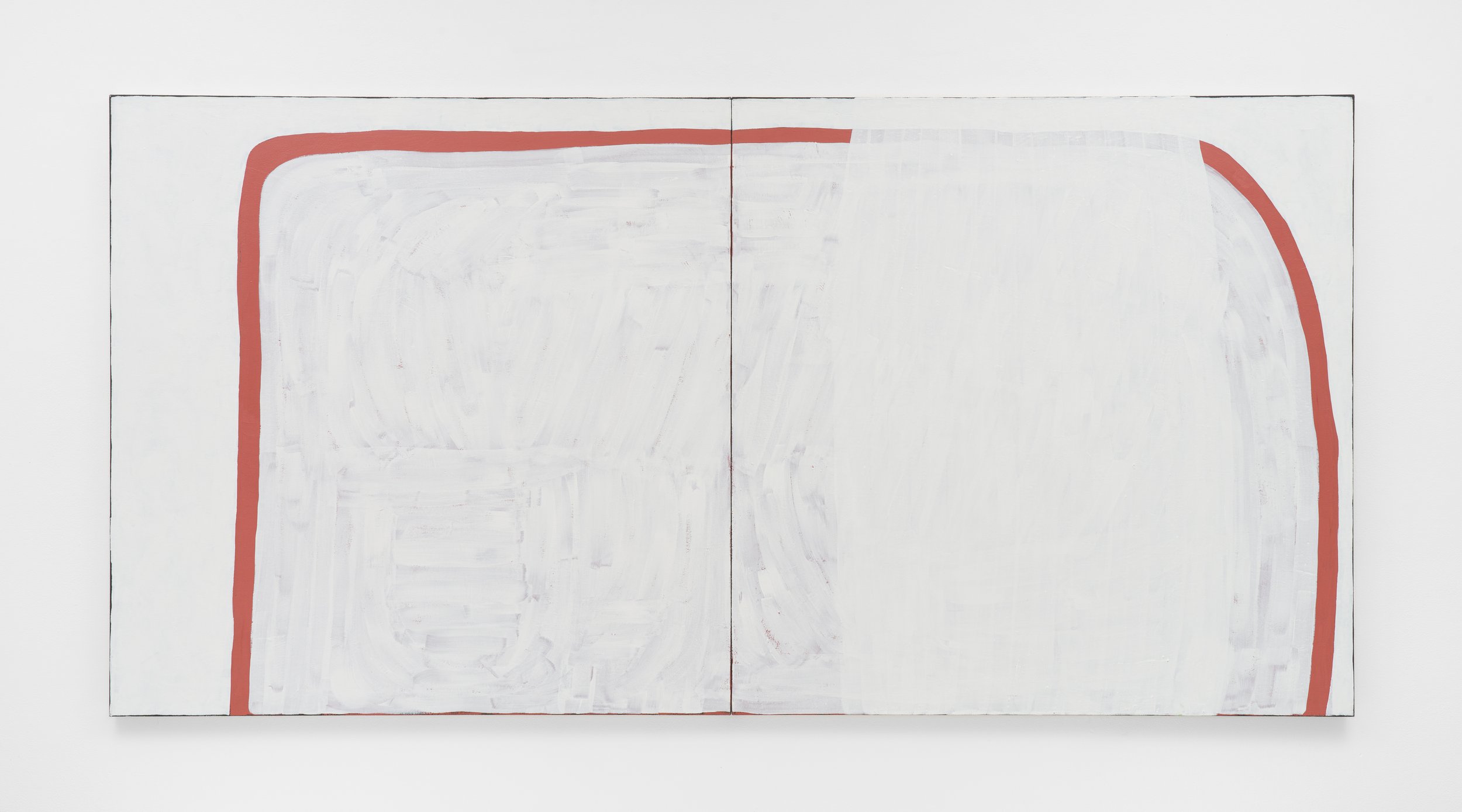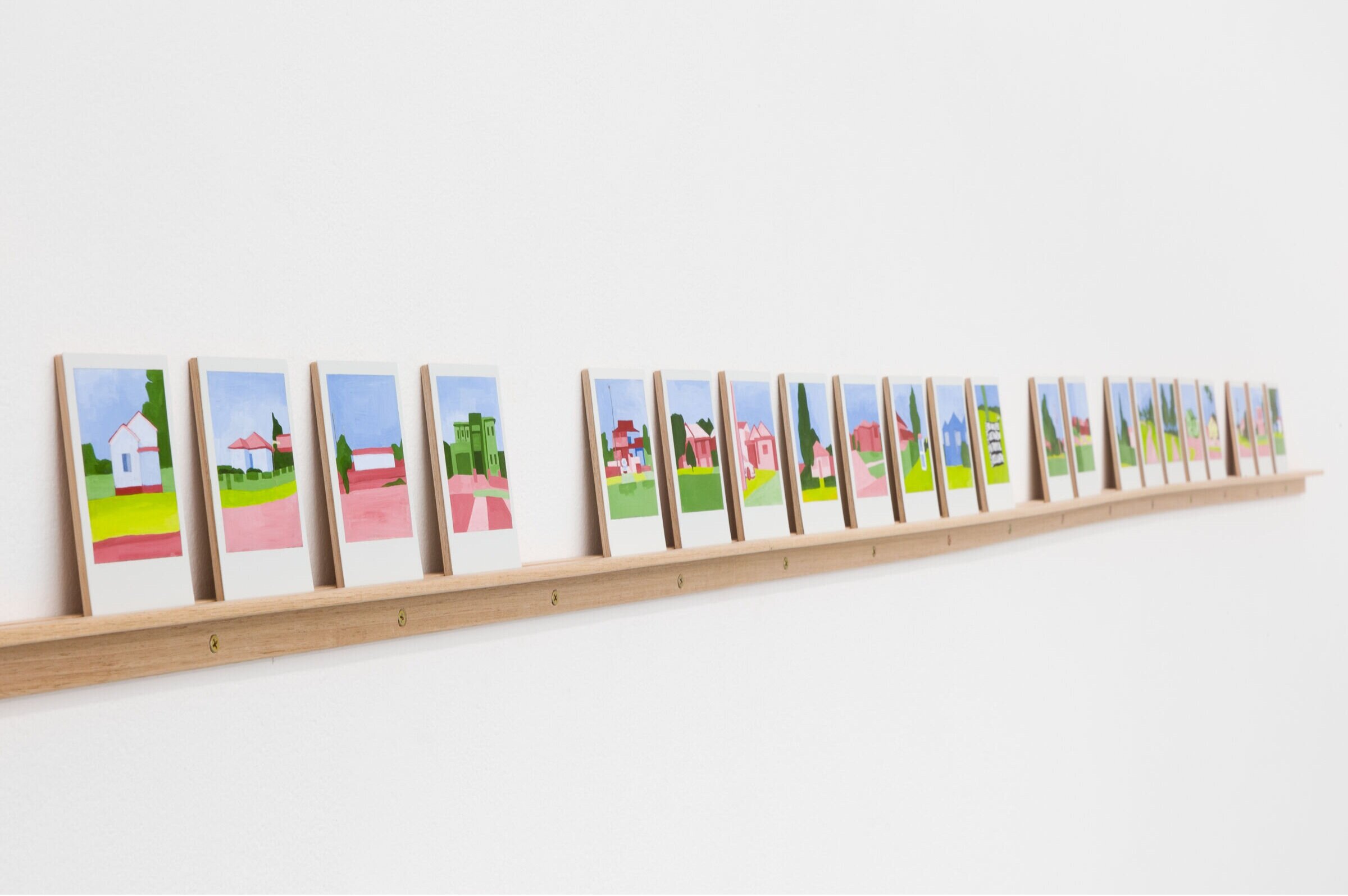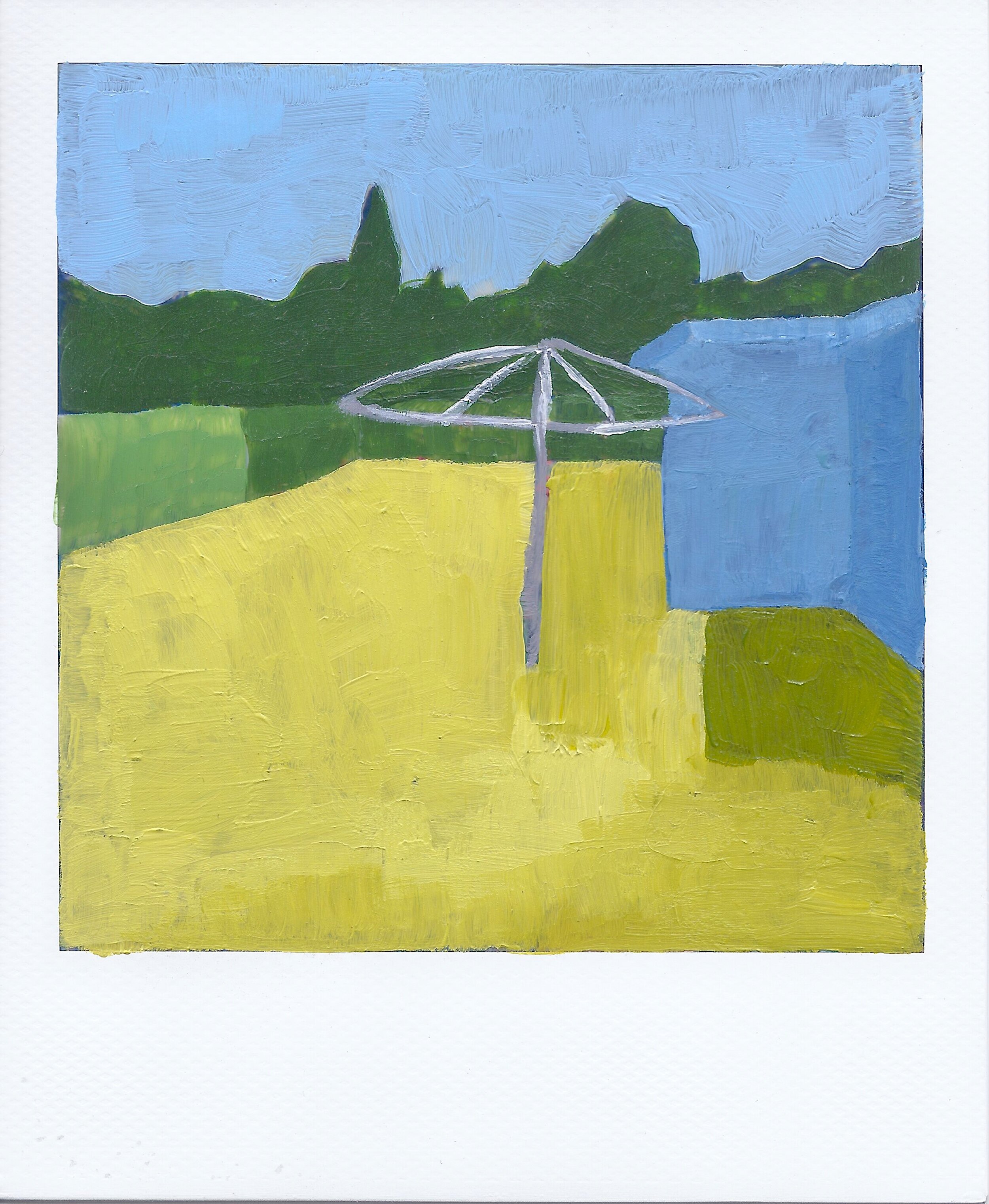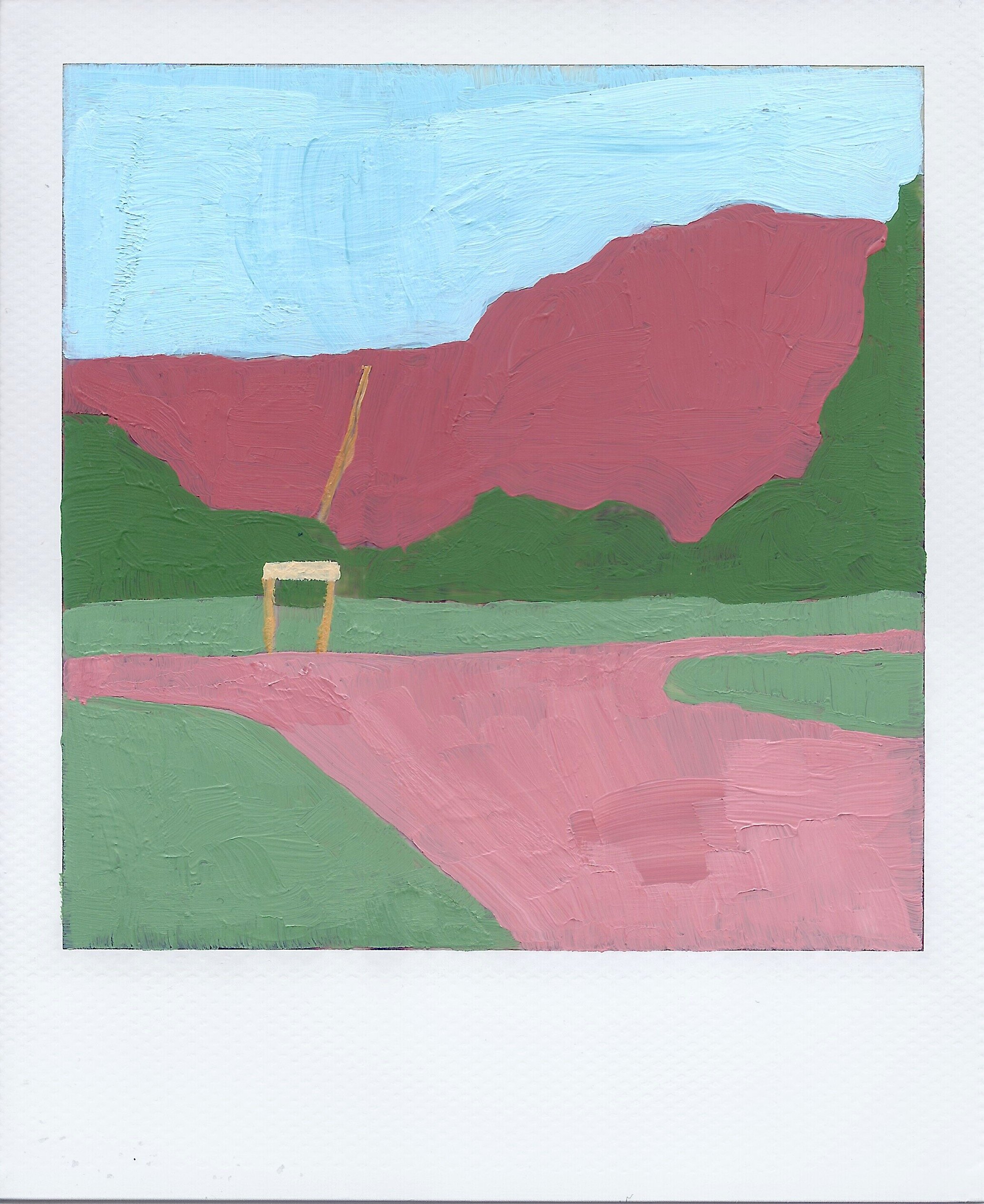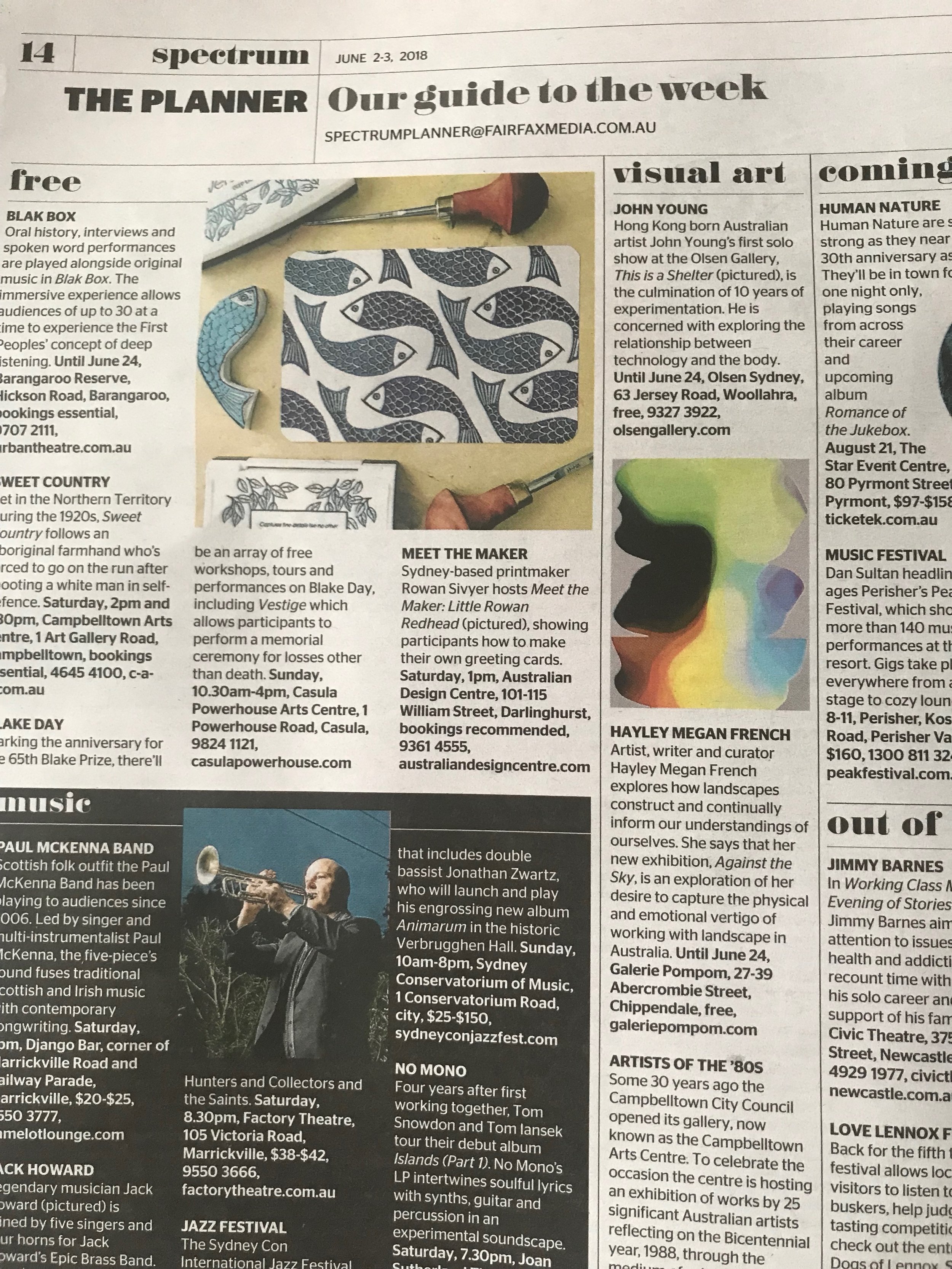Photo by Danica Knezevic
Dr Hayley French
Labor Candidate for City of Parramatta
After 6-years working with Parramatta Artists Studios and City of Parramatta in the Community and Culture team, I am taking a leap and running for City of Parramatta Council as the Labor candidate in the North Rocks Ward.
I grew up in this area and have stayed local my whole life. I have a vision for Parramatta where all residents feel a strong sense of belonging and are empowered to participate in the future of our city and its neighbourhoods. Access to our incredible local arts and culture is fundamental to this. I strongly support the ambitions of Parramatta in becoming a global creative hub and will advocate for individual artists and cultural organisations that are the beating heart of this growth.
If you want to learn more, you can follow my campaign at drhayleyfrench.com
Julia Roche - When Our Eyes Adjust
Wagga Wagga Art Gallery, 2024
Curated by Dr Hayley Megan French
In 2023-2024 I had the privilege of working as an independent curator and mentor for Julia Roche’s solo show When Our Eyes Adjust at Wagga Wagga Art Gallery as part of the gallery’s Regional Artist Development Program. Working on this project with Julia has been a highlight of my career. Julia is an incredible artist and human and I am so impressed by the risks she took in developing new work for this show.
In the development of this show, I was lucky to stay with Julia on her family farm Wooroola, visit her studio and witness several night painting sessions, with some beautiful photos taken by Jack of Hearts Photos - see below.
Julia’s exhibition was launched in Wagga Wagga Art Gallery in March alongside the touring Wynne Prize and Anna Louise Richardson’s touring exhibition The Good. At the launch we held an excellent panel discussion on curating living artists, with myself and Julia, alongside Anna Louise Richardson and curator Rachel Arndt, led by Gallery Director Dr Lee-Anne Hall. Since the exhibition in Wagga, Julia has shown the work at Defiance Gallery in Sydney, where we held an In Conversation event on opening night, 27 July, 2024.
Check out more on the show, and my exhibition essay, on the Curatorial Projects page.
Photo by Jack of Hearts
Photo by Jack of Hearts
In Conversation event at Defiance Gallery, Sydney, July 2024
2023 Bundanon Trust Artist-in-Residence
My recent residency at Bundanon Trust was my first time back in the studio after the birth of my daughter. It gave me space and time to develop new ways of working in and out of the studio; new rhythms and focus.
Looking for Patterns
I have spent my time in Bundanon looking for and collecting patterns. Patterns of trees, potholes, leaves and grass. Patterns of light and shadow. The movement of kangaroos and birds. Walking patterns, painting patterns, thinking patterns, working patterns. Collecting shapes, Polaroids, post its, words, colours. I have been collecting as a mode of being here, of focusing my attention and care to my surroundings.
I shared this note and some more images on the Bundanon Field Notes blog, where you can find other thoughts and works in progress from resident artists: https://www.bundanon.com.au/field-notes/looking-for-patterns-hayley-megan-french-artist-in-residence-august-2023/
2023 Bundanon Trust Artist-in-Residence
I am very excited to be an artist in residence at Bundanon in 2023. I look forward to the opportunity to develop new ideas and new ways of working in this incredible place.
Bundanon’s Artist in Residence program supports new work, research and collaborations by professional artists and researchers from around the world.
This multi-disciplinary residency program is the largest in Australia and provides artists time to conceive and develop new works and ideas in the iconic Shoalhaven landscape.
Read more here
New publication: The Pipeline Reading List, ADSR Zine 017, September 2022, ed. Elia Bosshard & James Hazel
I am really proud of this piece of writing published in ADSR Zine 017. I wrote this text while reflecting on the development of The Pipeline series and preparing to move out of the home in Guildford that sparked the beginning of this project.
You can read the full text here.
Excerpt:
The Pipeline Reading List
The Architecture of Happiness (2006) by Alain de Boton
The Pipeline project began when my partner and I moved into this house on Dharug Country, Old Guildford in 2018. Soon after we moved in, I picked up a copy of Alain de Boton’s Architecture of Happiness at a second-hand book fair. It was a fortuitous find. The book both articulated and inspired the relatonship I was building to the first home in which we have filled with everything we own; our belongings brought together from family houses, studio spaces and storage lockers (we both have hoarding tendencies though I prefer to think of myself as a collector).
I have surrounded myself with art in this house – works I have been collecting for many years and have held mostly in storage. Over time, I have come to realise it is not just the artworks that I love, or that make me feel at home. It is the way they hang from the picture rails. The way they interact with the geometry of the fibro panelling. The way they rest guardian-like above the thresholds.
Architecture works on us slowly, de Boton writes, “asking us to imagine that happiness might often have an unostentatious, unheroic character to it, that it might be found in a run of old foorboards or in a wash of morning light over a plaster wall…”
A very suburban kind of happiness.
The Architecture of Happiness has in turn inspired me to take more notice of the intensely personal nature of other people’s houses. Their temperament, their vices and virtues. To see every house as a home, and their collectve – a neighbourhood.
Within Walking Distance is open now at The Condensery, Somerset Regional Gallery, Queensland
10 September - 20 November 2022
New works on canvas from the Walking Paths series are being shown alongside 107 paintings in The Pipeline series in a solo exhibition across both galleries in The Condensery.
Visit The Condensery website.
See available works from this exhibition here.
ART EDIT Magazine Feature
My work is featured in the Spring 2022 edition of Art Edit Magazine. Read the article and see the works here.
Photo by Garry Trinh
The quality of light at dawn in Springfield Park, 2021, acrylic on canvas, 152cm x 304cm, photo by Docqment
Looking at Painting opening soon at Casula Powerhouse Arts Centre
I will be exhibiting new and existing works in the Pipeline series in Looking at Painting opening soon at Casula Powerhouse.
Hopper Gallery
10 July - 5 September 2021
Exhibition launch: 31 July (rescheduled to after lockdown)
Artists: NELL, Carmen Glynn Braun, Jody Graham, Rochelle Haley, Kirtika Kain, Hayley Megan French, Claudia Nicholson, Judy Watson, Nyapanyapa Yunupingu
LOOKING AT PAINTING features artists that push the boundaries of the canvas. It features a mix of emerging, mid-career and established artists who work with painting and experiment with the medium through approaches to collaboration, material, process and installation.
The artists explore very different themes and ideas through their artworks, but each has a unique story that starts with the mark-making of paint. Through this exhibition, audiences will see the diversity of the form of expanded painting today, and many of its possibilities.
Sydney Review of Books - Notes on Suburbia
Felicity Castagna & Hayley Megan French
A writer and an artist exchange ideas about suburbia, home and architecture occasioned by Hayley Megan French’s exhibit Three Houses Down at The Peacock Gallery in Auburn (August, 2020).
https://sydneyreviewofbooks.com/essay/castagna-french-notes-on-suburbia/
Photo by Docqument
Different Paths I have taken that remind me where I am, 16 January - 4 March, ALG, Toowoomba
Different Paths I have taken that remind me where I am opens at Alexandra Lawson Gallery on Saturday 16 January. There will be an artist talk at 2pm. The exhibition continues until 4 March and includes 13 new canvases mapping walking paths near my home.
Remembering walking paths near my home, 2020, acrylic on canvas, 102 x 102cm, Photographer Theresa Hall
Painting the suburbs, review by Catherine Skipper, July 2020
Excerpt:
We walk along looking closely at each tiny image, noticing the differences in colour palette, the detail or lack of it, the arrangement of trees, the deployment of space, much as we would if we were walking along a footpath bordering the broad road of an Australian suburb. In this way, we appreciate French’s observation that walking her neighbourhood was important to her process as it familiarised her with details that became inscribed as “home”.
The Pipeline at Galerie Pompom, 13 May - 21 June 2020
The Pipeline will be showing at Galerie pompom and online in May 2020. This exhibition will include 62 polaroid paintings from the pipeline project, and 12 new suburban line paintings. Keep an eye on my instagram page for the release of these works.
Semaphore x Suburbs
Hayley Megan French in correspondence with Robert Wood at The Border Line, published November 2019 on Semaphore: A weekly newsletter about art from Western Australia.
The Border Line
Hayley Megan French was the inaugural visiting artist with The Border Line in October 2019.
Read more: http://theborderline.com.au/hayley-megan-french/
Upcoming Exhibitions
2019 Hazelhurst Art on Paper Award, Hazelhurst Regional Gallery, Sydney, September
2019 NEXT, Sydney Contemporary Art Fair, Sydney, September
2020 (Solo show), Galerie pompom, Sydney, April
Sydney Morning Herald, Spectrum, June 2-3, 2018
I have been nominated as an Emerging Artist in this year's Redlands Konica Minolta Art Prize, 15 March - 22 May 2018 at the National Art School Gallery. Opening night is Wednesday 21 March 6-8pm.
"Nineteen of Australia's most respected contemporary artists have been selected by internationally recognised contemporary artist and Guest Curator Nike Savvas to present work in the 2018 Redlands Konica Minolta Art Prize at the National Art School Gallery in Sydney from 15 March until 12 May 2018. Nike has named this year's prize Extreme Prejudice.
Further information on the established and emerging artists can be found here.
'Vertigo' opening Friday 27 October, 6pm with an artist talk at Alexandra Lawson Gallery, Toowoomba.
2/5-7 Railway Street, Toowoomba, QLD
'The Place of Contemporary Australian Painting'
Dr Hayley Megan French presents a lecture on her PhD research at the Toowoomba Regional Art Gallery, Thursday 26 October, 5.30pm.
Dr Hayley Megan French will discuss ideas at the core of contemporary Australian painting today, driven by the questions that arise as an artist working in the unfolding discourse of the contemporary, the historical legacy of colonialism, and the unparalleled impact and influence of Aboriginal contemporary art on the Australian artworld. French argues that with a growing knowledge of Australian colonial and postcolonial histories, contemporary Australian painting challenges us to think differently, about what we think we know, about place-making, and about our response.
I am very excited to be part of the Stevenson Collection of New Zealand and Australian Contemporary Art located in Malborough, New Zealand. Check out some photos from the collection on facebook or @stevensoncollection on instagram.
The collection includes an old favourite of mine: freefall which you can see here:
https://www.facebook.com/763795633766200/photos/pcb.882695538542875/882695428542886/?type=3&theater
Unspoken (inspired by the art of Hayley Megan French), poem by Barbara De Franceschi, published in Eclectica, July/August 2017
Read it here: http://www.eclectica.org/v21n3/defranceschi.html
Art Collector, Nonggirrnga Marawili Artist Profile by Hayley Megan French, 2017
'Fingerprints in the paint', Nonggirrnga Marawili Artist Profile, Art Collector Magazine Anniversary Issue, Issue 80 Apr-Jun 2017, 154 - 159.
Canvas on FBi Radio, Sunday 9th October, 2016
Hayley Megan French & Carla Liesch talk about their collaborative work YOU ARE ONE OF THE REASONS I MAKE ART in Parramatta Lanes Festival, 11-14 October 2016. Listen here: http://fbiradio.com/945fm/programs/canvas/2016-10-09/
Art Collector, WHAT NEXT, Issue 76, 2016
Excerpt:
French is known for her striking black, white and orange abstracted landscapes. But her paintings aren't merely pleasing to the eye. The artist critically engaged with the formal pictorial elements of painting in a way that dynamically throws into question the traditionally dichotomous relationship between the Indigenous and non-Indigenous landscape traditions.
Carrie Miller, 2016
Art Collector 'WHAT NEXT - Hayley Megan French,' by Carrie Miller, Issue 76 Apr-Jun, 96-97.
The Sydney Morning Herald, The Shortlist, Friday 8 April 2016
NSW Artists' Grant Winners Announced, November round 2015
November Round
Lucas Abela - Temple Of Din installation at Cable festival in Nantes, France
Kate Blackmore - new website
Glitter Milita - Monsta Gras
Hayley Megan French - Hints of things we know
Hossein Ghaemi - Laneways Music Festival Artist Performance
Juz Kitson - Symbolic Order for Adelaide Biennial 2016
Deborah Mansfield - Something Immeasurably Better
Laith McGregor - NOONISMIDNIGHT
Jodie Whalen - Lifting My Weight
Artist Profile Auckland Art Fair 2016
The Red House
Penrith Regional Gallery
27 February - 22 May 2016
Hayley Megan French is an artist of serious intent. To watch her in the studio is to see an artist thinking, waiting upon, and finally painting one big idea across multiple canvases. Her idea and project is to consider land or ‘country’ as it is painted, thought about and experienced. In doing so she examines the influence of an Aboriginal world view and aesthetic - art practices, symbols and iconography upon the art practice of non-Aboriginal artists. Perhaps not intentionally, but achieving it none-the-less, she has both borrowed and created a lexicon in paint with which to express place, and relationship to place.
The works in The Red House are ostensibly landscapes, meditations upon the earth and time spent in the east Kimberley community of Warmun. French sat down in the country of this continent’s great artists: Rover Thomas, Mabel Juli, Freddy Timms, Queenie McKenzie and Paddy Juminj. And having sat down for a time, she began to paint her felt experience. The scale of these paintings speaks to the bigness of that experience. Large works stand in concert to each other as if one story, one never-ending story. They are both inchoate and articulate, and they seek a language that might be shared.
In each work the immense earth and sky is reduced to elemental forms, all carved with colour - black, white and orange. Paint is layered upon paint, paint upon canvas. Surfaces are scratched and scarred producing shadow, and a tracery of what lies beneath. Palette and method is both a distillation and explosion of experience. Is black the hallowed earth, the night or the colour of skin? Is it experience, depth, desolation or damage? Is white the blinding sun or the blinding skin? Is it the unseeable or the enlightened self? And is orange, just maybe, a disruptive happiness of artist finding country?
Dr Lee-Anne Hall
Director
Penrith Regional Gallery & The Lewers Bequest
March 2016
Download the digital catalogue here
CHASS Australia Prizes Winners Announced 2015
Excerpt:
CHASS has announced the winners for four categories of its prestigious 2015 Australia Prizes, which were presented at the CHASS Australia Prizes Lunch in Melbourne on October 15.
Hayley Megan French (The University of Sydney) won the 2015 CHASS Australia Prize for a Student. Other shortlisted nominees were Alexandra Roginski (Australian National University) and Betty Sargeant (RMIT University). The winner received a $500 voucher. Sponsored by the Co-Op, the Student Prize was for a student project, performance, exhibition or thesis that best exemplified the contribution of HASS areas to our understanding of our nation and us. Highlights of the afternoon included a keynote address by indigenous soprano and composer Deborah Joy Cheetham AO.
Art & Artists blog, 24 March 2015
http://artandartistsblog.net/2015/03/james-makin-galleryhayley-megan-french-georgie-roxby-smith/
Hints of things we know: the paintings of Hayley Megan French
James Makin Gallery 12 - 28 March 2015
Thinking about what to write about Hayley Megan French’s paintings presented me with a challenging problem and a simultaneous, wonderful, solution. I couldn’t decide which aspect of her work was more important. Was it abstraction? The slowness of those beautiful forms dancing in her work? Was it the landscape, and its fascinating contemporary transformation from colonial hangover (somebody call the art police) to a means of genuine spiritual enlightenment and even, at its best, a way of transcending cultural and historical barriers? Or was it simply French’s painting’s virtuous calm, the marks, the colours, and their satisfying, somehow quiet arrangements? A hard choice, but that is just it. All of these aspects are important, and perhaps that is why I find French’s work so compelling. It operates between moments, between paradigms, between thought and action, and that is exactly why I like looking at them. They refuse to be tethered to one idea.
I had a beautiful moment with one of French’s paintings while viewing the works that would make up the exhibition at James Makin Gallery. When she told me that the work in question was more figurative than she would have liked, I couldn’t help but smile, as I suddenly recognised two characters that had been appearing in her work for some time. Not that they are ever the same… two lumps, one titanium white and one cadmium orange, seemingly locked in conversation (or silence) for eternity. Mind you, they’re never the same size or shape. At best, they may resemble a wobbly Philip Guston character, or even Gumby and Goo (if you were being particularly fanciful), but they’re not what you would call human. They’re lumps, or rocks, or matter. It doesn’t matter.
I have always maintained that the best abstraction still incorporates some form within, hints of things we know, or understand, even if we cannot quite decide exactly what that may be. The idea that abstraction is completely divorced from representation, at least when the human hand is still present in its execution, is patently absurd. Every scrape and stroke and squib is evidence of our clumsy, ridiculous, wonderful bodies’ movements. In terms of describing the way our bodies actually move and work, I have never found anything more satisfying than dance (completely alien to my existence, but just as bewitching), drawing and painting. If you took the flawed, human aspect out of these art forms, you would have… what? Emptiness, or something close to it.
And this leads me back to trying to talk about space. French’s forms are always locked in conversation or engaging in silence (which is a kind of conversation itself), shapes in fields of darkness. Even the darkness in these paintings has character. Lines emerge from the inky darkness, almost impenetrable in deep purples, almost obsidian in their impenetrability. I had to laugh at the sheer cuteness of it. I mean, these guys were deep in conversation, something that could potentially occur over eons. Not that French’s work is ‘cute’, but transforming these beautifully painted forms in my mind to blobs having a chat in the desert over the millennia does appeal to me. Literal philosopher stones. There is something reassuring about the idea that there are rocks in the desert that have stood there for thousands of years, and will remain for thousands more, in a secret, silent conversation.
Also appealing to me is French’s own (very similar) conversation with the art around her. French’s dialogue reaches in equal parts into Indigenous art and European art. Nonggirrnga Marawilli is just as influential as Matisse, and aspects of both artists come through. There has been a politically-charged discourse around Aboriginal art in recent years, with some artists appearing to fan the flames with apparent cash-ins and cynical rip-offs, claiming the sanctity of satire or postmodernism as their get-out-of-art-jail-free-card. French has no need for any such gimmicks, for her investigation has been thorough, and respectful.
Finally, I realise that trying to evaluate French’s work in terms of some kind of theoretical or historical underpinning is really just selling the work short, riffing on my own art school jive talk. Not that these ideas aren’t important to her paintings. They are relevant to the work, but that’s not all they’re about, not by a long shot, and for that I am glad. They ask us so many questions, just as many as we have for them. Maybe the answers are all in there, in the work, staring right back at us. But this is all a part of the conversation we can now have with this work. This silent, beautiful conversation.
Jonathan McBurnie, 2015
‘Hints of things we know: the paintings of Hayley Megan French,’ catalogue essay for Hayley Megan French, 12 - 28 March 2015, James Makin Gallery, 67 Cambridge Street Collingwood, Victoria, Australia.
Marten Bequest Winners Announced, 10 March 2015
Hayley Megan French: new paintings
Is it somehow possible to experientially analogise the kinds of tensions that play out between cultural projections and geological formations within a relationship between the immateriality of the art condition and the physical stuff of suspended pigment on canvas? Much like the fictional world we call art, cultural projections such as nation only exist to the extent that people agree that they do. Far from enjoying any fixed or permanent status, let alone maintaining full consensus, cultural objects are thought into existence in many and conflicting ways. Although exercised via the immaterial functions of collective imagination, actions performed in the image of national identity nonetheless wreak tangible physical markings, scars, erasures and layers upon and within geological formations – let alone their impact upon pre-existing cultural projections.
The island continent that we call Australia is at once a timeless physical geological formation and a historically layered series of cultural projections. Significantly, this island continent quite literally bears the same outline shape as the recently collectively imagined symbolic projection of nation that we now call Australia. For a mere blip in historical time, an obscenely new cultural projection has been superimposed over both the ancient geological formation that is its host, and by extension, the several hundred nations existing for many tens of thousands of years previously. Although the idea of landscape is seen as central to a sense of being in Australia, it also invariably evokes complex and unresolved historical, cultural and political tensions played out over a deep and long geological presence. Artists that deal with the idea of landscape in Australia are by default perpetually connected to these tensions—which are of course never more conspicuous than wherever they are refuted. Hayley Megan French is clearly mindful of the potential for art to play an implicit role within our abstracted experience of these deep, long and ruptured relationships. For French, conspicuous erasures and absences coupled with tentatively specific yet formless shapes work in silent concert to imply half forgotten and provisional unions within expanses of seeming emptiness—which upon closer inspection still maintain the scars and textures of previous registers of gestural incursion.
French’s latest paintings are layered and textured—white on black, orange on white, black and more black. Created through processes of sequential layering and erasure, these paintings are clearly not literal descriptions of landscape. By contrast, French transposes the kinds of relationships, gestures, and erasures that have played out within and across this ancient land into the language of painting. Offering no horizons or specifically mappable points of reference, French’s shapes appear to float in space and place, faintly echoing latent, invisible, and stubborn contradictions that dwell within the dreams, fictions and errors through which we have constructed our sense of being in this land. Some of these fragments are foregrounded. Others have disappeared in erased markings that still echo gestures that can now only be imagined. For painting, like landscape, is finally a register of performance enacted upon its surface.
Painting remains a fertile ground on which to stage a dynamic play between a literal register of information and a space for the imagination to flourish. Here, conspicuous omissions and evacuations of the specificities of content can simultaneously imply a desolation that denies the past and make provisional connections within which to rebuild. In this way, French repeats cycles of consumption and excretion inextricably tied to our destructive yet fragile human condition and its dependence upon land. By orienting in thought through imagined spaces and formless shapes towards a land that actually exists, French provides a perceptual conduit for repurposing the play of invisibility and the limits of imagery. Just as vast expanses of landscape can provide solace and histories imbue feeling simply via our knowledge of their existence, art can facilitate forms of experience that exist beyond direct sense perception. By building experiences in the mind through the tangible materiality of paint, yet mindful of the paradoxical insight that full comprehension is impossible, French provides us with an effective vehicle for imagining the poetic play of absence and transsubjective identity.
Sean Lowry 2014
‘Hayley Megan French: new paintings,’ catalogue essay for See where it drifts, 28 May - 22 June 2014, MOP Projects exhibition hosted by Galerie pompom, 2/39 Abercrombie Street, Chippendale NSW, Australia.
Art Collector 2014 Undiscovered Artists Feature
Excerpt:
An intense palette, naive shapes and movement cast in thickly layered acrylic paint characterise the work of Sydney-based artist Hayley Megan French, whose intelligent painting practice is going from strength to strength.
French's large-scale abstract paintings incorporate warm orange, stark white and black, with forms that oscillate across the canvas. They are visceral and sensitive observations about the Australian landscape and painting. And, more recently extending from French's current PhD in painting at Sydney College of the Arts, the conceptual and experiential potential the canvas offers Aboriginal and non-Aboriginal painters and contemporary artistic responses - an important line of research for a young Australian artist and which aesthetically offers audiences scope for their own reflection.
Altair Roelants, 2014
Art Collector '2014 Undiscovered Artists - Hayley Megan French,' by Altair Roelants, Issue 68 Apr-Jun, 96-97.
Interview with Jonathan McBurnie, sneakymag.com, 26 May 2014
Jonathan McBurnie (JM): Tell me about your new exhibition. I believe it is your first ever solo show?
Hayley Megan French (HMF): It is my first solo exhibition. The thing I am most excited about is the opportunity to show a whole series of paintings. I have always worked in series, however other than my grad shows at Sydney College of the Arts (SCA), I have not had the opportunity to show more than two paintings together.
The series I am exhibiting is part of a consideration of landscape as central to an experience of being in Australia. This connection evokes complex and unresolved histories and cultural projections, layered over the land. The paintings are not literal descriptions of landscape, but a way of thinking through my relationship to the ideologies of landscape in Australia, through the language of paint.
The show is titled See where it drifts and opens this Wednesday night, May 28 at Galerie pompom in Chippendale. I am exhibiting in Galerie pompom as an invited artist through MOP Projects, an artist-run space with which pompom has a collaborative relationship. I am very lucky to be part of this new program which invites unrepresented artists to exhibit in a reputable commercial gallery, with all the perks of publicity, administration and installation support. It has been an incredible experience just in the lead up and I am very much looking forward to installing and opening the show this week. I may be bias, but after working on the committee of MOP Projects for the past five years I think we can look forward to exciting things from this hybrid gallery model, expanding opportunities for emerging artists.
JM: For those new to your work, how would you describe them?
HMF: I always find it very difficult to describe my paintings, I feel as though I need to detach myself a little in order to do it. So, objectively speaking, the work in the show is a series of large, minimal abstract paintings with stark white and orange shapes moving about on a black background. On closer inspection, the background is heavily layered—the shapes are in fact fragments, not floating but anchored by shapes below the surface which bleed through the black paint. The colours themselves are layered, white over black, orange over white, black over the top. The underpainting is often evident in the edges of the shapes, as are the brushstrokes, which while controlled, are quite thick and rough. In a shift from my previous works, these fragments have been detached from the edges of the canvas and move about within the frame. Throughout the series there is a subtle negotiation of space and colour.
JM: You are working on your PhD right now. How has the experience been
in terms of your studio practice?
HMF: I am still in the very early stages of my career so this experience has had a dramatic impact on my studio practice. To begin with, being able to work close-to full-time on my practice for a number of years has allowed me to thoroughly work through ideas as well as experiment with new ones. The relationships I have developed with my peers and teachers have also been fundamental to my development, as well as leading to quite a few collaborative projects. Come to think of it, it was a collaborative work with Stephanie Quirk in 2011 that first led me to using cadmium orange, which now features strongly in the paintings. Most importantly, it has given me the opportunity to critically consider the field I am working in, which I see as an important start to my career.
JM: How do you balance both studio and thesis? Do you have a routine, or are you more scattergun in your approach?
HMF: The two are inherently intertwined, which in a way helps me balance the writing and the studio time. In particular, if I am having any problems, often switching between thesis and painting can help me work through these problems. Of course at times, there is less of a routine, especially if I am getting ready for an exhibition or having to madly write for a deadline. I definitely notice if I have been out of my studio too long though, I start to get frustrated and anxious. I do need the balance.
JM: You've been interviewing a lot of artists as a part of your research, some of whom have not gotten much academic attention. Have there been any particular highlights for you?
HMF: Interviewing artists has been the highlight of my research. I was very nervous, at first, to approach people, but it has been overwhelming how generous many people have been with their time and ideas. It has been such a pleasure to find artists, curators and historians with whom I can have honest and productive conversations about what it is to be making paintings in Australia today. I remember fondly one of my first interviews with Nick Pike. I drove up to his house in the Blue Mountains where he was also working from. We had a really great chat about his paintings and his thoughts on the Australian painting scene after returning from living in the US for a few years. I think it is incredibly important to the research, to be speaking directly to artists about their work and their thinking. On top of this I have been able to travel to quite a few places in Australia now as well as visit some great studios. Having said that, I think some of the interviews I have done with Sydney-based artists, as well as a few of my peers at SCA, have been incredibly valuable in finding artists with similar areas of interest that I will continue to work with.
JM: You have had a few research trips to remote indigenous communities, and another coming up. Tell me about that.
HMF: I have been incredibly lucky to spend time working in the art centres in Warmun in the East Kimberley region and Yirrkala in Northeast Arnhem Land. They really have been life-changing experiences for me in many respects. The trips have been a significant part of the research project; particularly in thinking through the major influence many remote artists have had on the wider field of contemporary Australian painting and specifically on my own practice. It is quite an honour to witness an artist at work and gain an insight into their process. I learnt a lot about the work, the artists and the cultures I wanted to write about this way. I am looking forward to returning to Yirrkala in July this year, in particular to learn more about the work of senior Yolngu artist Nonggirrnga Marrawali whose latest paintings have informed my thinking in both the studio and the thesis on what it means to be influenced by Aboriginal painting.
JM: To me, the relationship the art world has with indigenous artists has brought about some really great empowerment and also cross-cultural awareness in terms of indigenous issues, but also some really bad cases of exploitation. I have also noticed a distinct lack of focus on such issues in the last few months, which not coincidentally, coincides with the last election. You have seen both worlds first-hand. What changes in policy or just general human interaction would you like to see in this respect?
HMF: I am not an expert on policy, and I can only speak from my brief experience. In my experience of this research project, and in particular visiting the remote communities, I am aware the more I learn, that is very difficult to be informed across the full spectrum of arguments and experience. I have also become increasingly aware of my very specific and contextual perspective—this has in fact been one of the most interesting outcomes of doing a PhD. The comment that I will make is that, from the perspective of living in the city, it is glaringly obvious that we need to improve our education system and strengthen our learning on Aboriginal cultures and the history of Australia. It is very difficult for people to form healthy relationships when our education in this regard is so lacking and has been for far too long.
JM: Back to your exhibition. This body of work is obviously quite abstract, but also seems to incorporate elements of the figurative.
Whose work informs this kind of tension in your work? I am reminded of Richard Serra, Sally Gabori and, in a weird way, Paul Gauguin.
HMF: I suppose the shapes in these works do appear somewhat figurative, perhaps in part due to the bodily scale of the paintings. It was really more the movement of the shapes that came into play here, created through an erasing of larger shapes that initially referenced a kind of framing of the space within the canvas. I think there is a tension in the figure/ground relationship—the shapes are at times foregrounded, at others, determined through a process of erasing, foregrounding the black over-painting. This kind of tension has been played with throughout the history of western abstraction, but yes, Richard Serra along with Tony Tuckson, Robert Motherwell, Ian Fairweather and Debra Dawes come to mind. In fact, Debra had a huge impact on the way I now approach painting during my undergraduate studies. I was standing on a chair, painting circles on a 2m canvas when white paint dripped off my brush onto the finished part of the painting. Debra came running into my studio after I sort-of screamed and said very quickly to me, not to touch it. After much deliberation I did leave the drip and the process of making has become more and more evident in the surface of the works since then. As I mentioned also, Nonggirrnga Marrawali has been a big influence on this series, particularly through the spatial relationships of her latest bark paintings.
JM: Best of luck for Wednesday night.
HMF: Thanks Jonathan, I appreciate it.
Around The Galleries with Sandy Pottinger, The Chronicle, Saturday, September 14, 2013
Excerpt:
Share these exhibits
Raygun Art Projects, 249 Margaret St, is hosting "Wall Painting: The Exhibitions", the documentation of an artwork by Hayley Megan French and Carla Liesch. The work itself began as a site-specific installation, a wall with a doorway on stretched canvas that effectively divided the gallery space.
Its removal at the end of the exhibition suggested a new role as a performance piece and it was then toted around galleries and key landmarks in Sydney.
The physical presence of the wall encouraged interactive audience participation, while its peripatetic progress was recorded in photographs and video, the documentation thus generating another aspect of the work.
The visual essay encourages viewers in a series of propositions with respect to space as a construct, notions of concealing and revealing, entrances and exits, even the nature of illusion and reality.
Underpinning the serious considerations, however, is a refreshing degree of humour and a sense of the absurd.
Sandy Pottinger, 2013
















